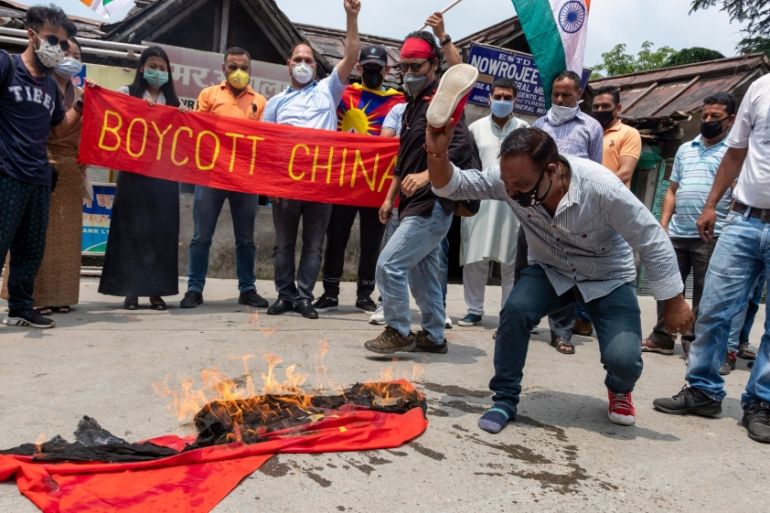Modi denies Chinese incursion into India before deadly clash
PM’s remarks came after talks with party heads, with opposition leaders raising the issue of intelligence failures.

India’s prime minister has said the country is “hurt and angry” at the killing of 20 soldiers by Chinese forces in a disputed Himalayan border region, but appeared to downplay the incident in a public address, denying there had been any incursion into Indian territory.
“Nobody has intruded into our border, neither is anybody there now, nor have our posts been captured,” Narendra Modi said in a televised speech on Friday after he spent the day meeting representatives of parties from across the political spectrum in a bid to build consensus to tackle the rising tensions with China.
Keep reading
list of 2 itemsIndia says China’s Galwan Valley claims ‘untenable, exaggerated’
He assured political leaders “that our forces will spare no effort to protect our nation”.
China and India, both nuclear-armed countries, accuse each other of instigating the fight this week in the Galwan Valley. There is little evidence of what led to Chinese and Indian soldiers engage in the brawl on Monday. It was the deadliest incident between the two sides in 45 years, although China has not said whether it suffered any casualties.
Modi’s comments contrasted with his government’s earlier statements on the clash.
On Wednesday, Foreign Minister Subrahmanyam Jaishankar had told a senior Chinese diplomat that the dispute was triggered after “the Chinese side sought to erect a structure in Galwan valley on our side of the LAC”, according to a ministry statement, referring to the Line of Actual Control, the de facto border.
|
|
China on Friday maintained its position that India was to blame.
“The right and wrong is very clear and the responsibility lies entirely with the Indian side,” Foreign Ministry spokesman Zhao Lijian said.
On Friday, a source told Reuters news agency that despite daily meetings between Indian and Chinese military officials at the LAC, “the situation remains as it was, there is no disengagement, but there is also no further build-up of forces”.
Questions over intelligence
Modi spoke following a three-hour all-party meeting. He held a virtual meeting with the heads of more than a dozen top opposition parties.
Sonia Gandhi, the chief of main opposition Congress party, questioned whether intelligence failures had allowed China to build up forces in the area.
“Does the government not receive, on a regular basis, satellite pictures of the borders of our country? Did our external intelligence agencies not report any unusual activity along the LAC?” Gandhi asked.
She added the “entire country” would like assurances that China will move its forces back to the LAC. Other opposition leaders echoed her call.
Defence Minister Rajnath Singh denied there was an intelligence failure on the part of the army.
Anti-China sentiment grows
While both sides have said they favour a resolution through dialogue, anti-China protests across India and domestic pressure on Modi may make it difficult to calm the situation without more concrete action.
A movement to boycott products from China, India’s largest trading partner, has gained momentum since the clash.
Authorities have cancelled a railways contract with a Chinese firm and at least four Chinese firms involved in other Indian projects also stand to lose business.
Meanwhile, state-run telecom firms have been told to forego Chinese telecommunications equipment in favour of locally sourced material for upgrading 4G mobile networks, Indian media reported, while a major traders’ body, the Confederation of All India Traders, has called for a boycott of Chinese goods.
|
|
Also on Friday, Indian media reported that China had freed 10 Indian soldiers seized in the clash following several rounds of talks late on Thursday.
Hours later, China denied it had detained any Indian soldiers.
China claims about 90,000 square kilometres (35,000 square miles) of territory in India’s northeast, while India says China occupies 38,000 square kilometres (15,000 square miles) of its territory in the Aksai Chin Plateau in the Himalayas, a contiguous part of the Ladakh region.
India unilaterally declared Ladakh a federal territory while separating it from disputed Kashmir region in August 2019. China was among the countries to condemn the move, raising it at forums including the United Nations Security Council. India was elected to the UNSC this week.